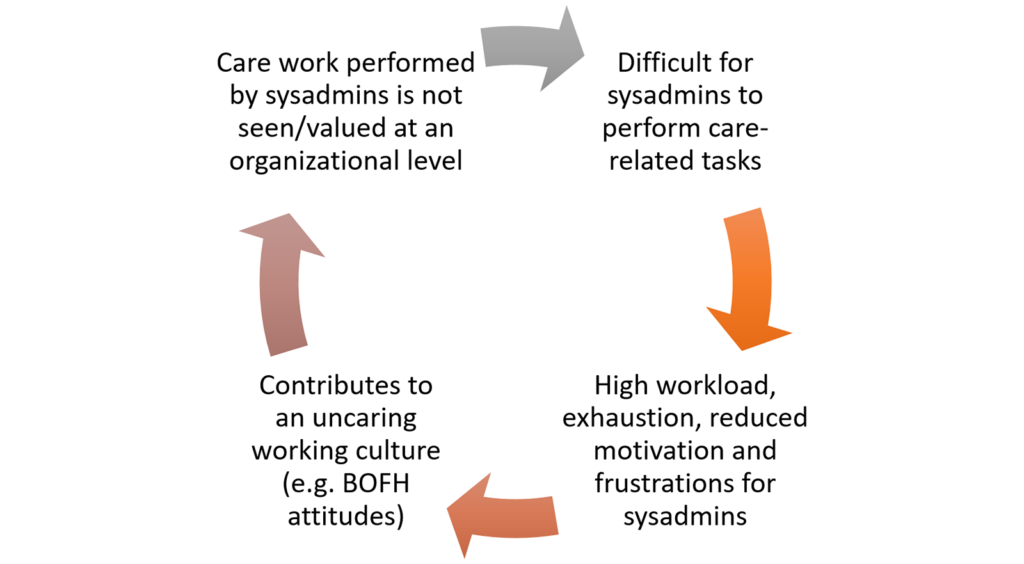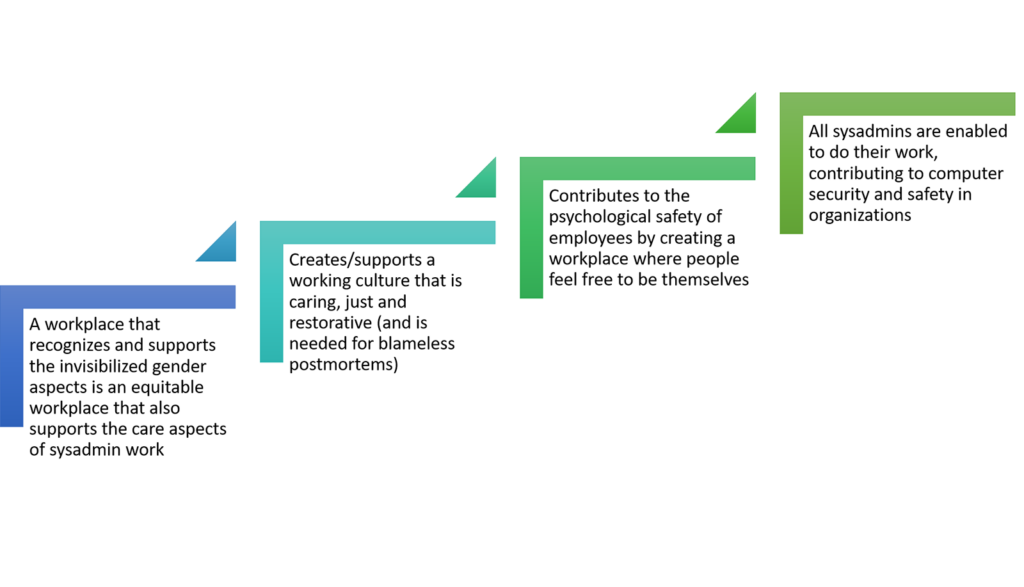
In the system and network administration domain, gender diversity remains a distant goal. The experiences and perspectives of sysadmins who belong to marginalized genders are not well understood beyond the fact that sysadmin work environments are generally not equitable.
Using a feminist research approach, my co-authors and I at TU Delft, Max-Planck-Institut für Informatik and George Washington University investigated the work of sysadmins who belong to marginalized genders in the sysadmin profession, specifically, people who are not cis men. We focused on ‘non-cisadmen’ (*sysadmins who are not cis men) and the ways in which they manage their work in male-dominated sysadmin workspaces and understanding what an inclusive workplace would look like.
We engaged with 16 non-cisadmen located in seven economies (Germany, United States, Austria, France, Belgium, India, and Canada) via six online focus groups. Each focus group lasted around 90 minutes with two to four participants per group. The focus group revolved around three main topics, namely:
- The easy aspects of work.
- The difficult aspects of work.
- Ways of overcoming difficulties at work.
Our main findings are as follows:
- We find that managing the impact of gender identity in the sysadmin workplace means being excellent and going above and beyond in system administration tasks. We highlight the invisible and undervalued aspects of sysadmin work, and how the participants’ gender compounds these effects even further.
- We identify and highlight the so-far understudied care work and emotional labour aspects, which are an instrumental part of sysadmins’ work.
- We explore and describe the negative interactions within non-inclusive environments and how hostile non-inclusive workplaces elsewhere inhibit career advancement in inclusive work environments due to one ‘feeling stuck’.
- We identify the role of non-management facilitated communities and bottom-up self-organization in creating inclusive environments.
We developed recommendations for enabling sysadmin work from three perspectives — related (feminist) research, participants’ input, and authors’ insights.
Summarized below are the recommendations that we submitted in our paper, the preprint of which is now available.
The participants’ recommendations
- Fostering a supportive workplace: A supportive workplace is one that is inclusive. It is where teams consist of people from diverse backgrounds and where the working atmosphere is based on mutual understanding, trust, respect, openness and transparency. Participants’ suggestions include:
- Hiring from a more diverse pool of people that is inclusive of immigrants, disabled persons, marginalized genders, and so on.
- Enabling a working culture that puts people first such as via timely promotions, sensitivity towards topics of race/gender/sexuality/disability, and being vigilant of one’s own implicit bias and prejudice regarding others.
- Facilitating an inclusive working atmosphere by having relatively flat hierarchies and supportive management that rejects outdated traditions such as solely hiring female secretaries.
- Having an HR department that truly implements its progressive policies and is supported by the management.
- Define and follow formal processes for equity: It is vital to have Diversity, Equity and Inclusion (DEI) practices and HR policies in place that uphold equity and protect from discrimination. These policies exist on paper but are not well-implemented and followed, if at all. Having tangible goals and metrics to measure progress are necessary to ensure that these policies are rightly followed. Examples of suggestions from participants are:
- “have a clear picture and write it down, what the just and inclusive workplace looks like”; “get the data of where you are right now and plan/interact with the employees how you can get to your ideal”, and use “data-driven analytics with regard to inclusion and social skills”.
- Move towards soliciting open text inputs for improvement ideas in specific areas and asking detailed questions like “how accessible do you think our workplace is”, “what changed for you, if anything, since last time” and “what would help you” instead of the usual “how is the work-life balance”.
- Move away from questionnaires/surveys with a five-point rating/Likert-like scale and a generic comments box at the end.
The authors’ recommendations
Care more for care-work: The invisibility and unawareness of sysadmin work mean it is underestimated and under appreciated. It’s a self-reinforcing circle where the undervaluation of care work on an institutional level increases the frustration of performing invisible care work and leads to uncaring work environments, for example, BOfH. This, in turn, affects the organizations’ interaction with and treatment of sysadmins, as shown in Figure 1.

We hypothesize that a workplace culture of community and care has the potential to disrupt this cycle and maybe even reverse it. Therefore, we recommend caring more for care work by:
- Recognizing the vital contribution of sysadmins in forming the bedrock of modern digital society, and making this work more visible and valued.
- Recognizing the operations-critical nature of care work.
- Not putting the responsibility of making this work visible on the sysadmins themselves.
- Instead (re)building organizations around a working culture that is just, caring, and that enables operators to realize positive outcomes.
Enable secure system operations by creating feminist work environments: An equitable, just, and feminist workplace is one that is inclusive and accessible to all, recognizes the many gendered aspects and care aspects of sysadmin work that is invisible, cares for them by understanding and valuing them, and supports sysadmin work as it is done in practice.

A work environment as shown in Figure 2 fosters a just work culture, which we believe is essential to perform secure and reliable systems operations. In summary, a safe and equitable workplace in which people can be themselves contributes to computer security and safety in organizations.
Please refer to our paper “Oh yes! over-preparing for meetings is my jam :): The Gendered Experiences of System Administrators” to learn more about this work.
Mannat Kaur is a PhD researcher at TU Delft, the Netherlands.
The views expressed by the authors of this blog are their own and do not necessarily reflect the views of APNIC. Please note a Code of Conduct applies to this blog.

Wonderful. So much detail and research. An Excillent effort
An excellent article and a wonderful effort. Exceptional